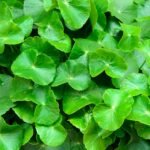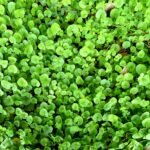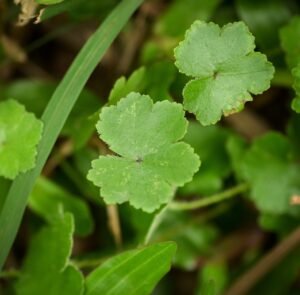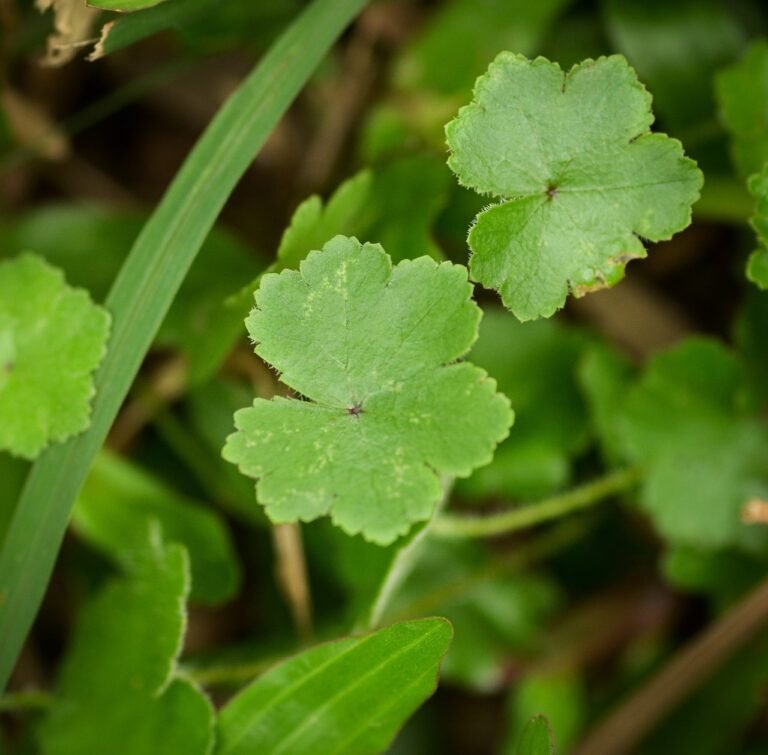Frequently Asked Questions
Frequently Asked Questions
Overview
Centella asiatica, also known as Gotu Kola, is a herbaceous plant native to the wetlands of Asia, particularly in countries like India, China, Indonesia, Sri Lanka, and Madagascar. It has a long history of use in traditional medicine systems such as Ayurveda, Traditional Chinese Medicine (TCM), and African traditional medicine.
Descriptions of Mandukaparni are found in ancient Indian texts like those by the sage Charaka, who is one of the main sources of Indian medical knowledge. It has been praised for its mental, medicinal, and physical health benefits.
Mandukaparni’s uses in Ayurveda continue today due to its numerous beneficial properties.





Centella Asiatica In Your Language
Family
Synonyms
English
Apiaceae (एपिएसी)
Hydrocotyle asiatica
Indian Pennywort (इण्डियन पेनीवर्ट) ,Marsh pennywort, Sheep rot.
Sanskrit
mandukaparni (मण्डूकपर्णी), manduki( माण्डूकी), brahmi( ब्राह्मी) saraswati(सरस्वती), maduki (मडूकी), divya (दिव्या), supriya (सुप्रिया), brahmamanduki (ब्रह्ममाण्डूकी), darduchchada (दर्दुच्छदा)
Hindi
Brahmamanduki Mandukparni(ब्राह्ममाण्डूकी मण्डूकपर्णी )
Urdu
Brahmi (ब्राह्मी)
Odia ( Odiya )
लंबक (Lambak)
Assamese
Manimuni (मानीमुनी )
Kannada
Urage(उरेज ) ,बोंडेलाजे (Vondelaga)
Gujarati
खड़ब्राह्मी (Khadbrahmi), मोटी ब्राह्मी (Moti brahmi)
Telugu
मण्डूक ब्राह्मी (Manduk brahmi), सरस्वातकू (Saraswataku)
Tamil
बल्लौ (Ballo), वल्लरै (Vallerei)
Nepali
घोडाप्रे (Ghodaapre), गोलपात (Golpat)
Marathi
Marathiकारिवणा (Karivana), ब्राह्मी (Brahmi)
Malayalam
कोण्डागल (Kondagal), मुयालचेवी (Muyalchevi)
Persian
Sardeturkastan
Arabic
Jharniba
Physical Appearance of Centella asiatica
Centella asiatica, commonly known as Indian pennywort or Gotu Kola, is a small, herbaceous plant that typically grows in moist, tropical environments.It is a weak, ground spreading, slightly aromatic, climbing herbaceous plant. Here’s a description of its physical appearance.
Leaves :Its leaves are simple, 1.3-6.3 cm wide, emerging from the stem in large numbers, spherical, kidney shaped, perhaps wider than the length, highly toothed, green in color with 7 veins and hairless and rough on both the surfaces.
Stems :The stems of Centella asiatica are slender, creeping, and root at the nodes. They can spread horizontally, forming dense mats on the ground.
Flowers : Centella asiatica produces small, inconspicuous flowers that are arranged in umbels or clusters. The flowers are usually white to pinkish in color and have five petals.
Fruits: After flowering, Centella asiatica develops small, round fruits that contain seeds. These fruits are not typically a prominent feature of the plant’s appearance.
Roots : The roots of Centella asiatica are thin and fibrous, spreading horizontally as the plant creeps along the ground

Chemical Composition of Centella asiatica
Benefits of Centella asiatica ( Uses of Centella asiatica )
There are several benefits of Centella Asiatica in many diseases. If you are serious about your health, then your search ends here.
Hair disorders
- Consume 1 teaspoon of Brahmi-Panchang powder regularly in the morning and evening for a few weeks. This experiment is also beneficial in preventing weakness.
Eye disease (Eye ulcer)
- Putting 2-3 drops of Mandukaparni-patra-swaras in the eye is beneficial for eye ulcers.
Nasal disease
- Consuming a decoction prepared from Pinus Mandukaparni, Marich, and Kulthi is extremely beneficial. During this period, one should always consume lukewarm water.
Throat disease:
- Swar Prasad Narth – Mix 100 grams of Brahmi, 100 grams of Munakka, and 50 grams of Shankhpushpi in four times the amount of water and extract the mixture. With its use, the body becomes healthy, and the voice becomes clear.
Kidney disease
- Mixing one spoon of sugar candy in 2 spoons of Brahmi juice and consuming it removes urinary obstruction.
Osteoarthritis
- There are several benefits of Centella Asiatica in many diseases. If you are serious about your health, then your search ends here.
Skin Disorders
- Applying a paste of Pidika-Mandukaparni-Swaras helps in alleviating Pidika (pimples).
- Using a mixture of Masurika-Mandukaparni-Swaras with honey benefits Masurika (a skin disorder).
- Applying a paste of Twakvikar-Mandukaparni-Patra-Swaras helps in the treatment of Kandu (itching), Kshat (injury), and Vrana (wounds).
- Administering Mandukaparni-Patra-Swaras mixed with honey benefits Masurika (a skin disorder).
Mental Disorders
- Enhance Memory Power-Combine 1 part dried Mandukaparni, 1 part almond kernel, and one-fourth part black pepper soaked in water, each weighing 3 grams, to form tablets. Administer one tablet daily in the morning and evening with milk to boost brain power.
- 3 grams Mandukaparni, 3 grams Shankhpushpi, 6 grams almond kernel, and 3 grams small cardamom seeds soaked in 50 ml water, strained, and mixed with Mishri. This mixture is very beneficial not only for memory power but also for cough, bilious fever, and chronic insanity.
- Take fresh juice of Mandukaparni, mix an equal amount of ghee, prepare clarified butter (ghee) from this mixture, and consume it in a dose of 5 grams. Consuming this Panchang powder with milk enhances memory power.
- Insanity : In 6 ml of Mandukaparni-Swaras, mix 1 gram of Kutaja (Holarrhena antidysenterica) powder and 6 grams of honey. Consuming this mixture three times a day is beneficial for insanity, including Pittaja (bilious) unmad (insanity).
- Take 3 grams of Mandukaparni, 2 black peppers, 3 grams of almond kernel, and 25 grams of Mishri (crystallized sugar), soak them in water, strain, and consume in the morning and evening. This is beneficial for Pittaja (bilious) unmad (insanity).
- Soak 3 grams of Mandukaparni and some black peppers in water, strain, and consume 3-4 times a day to alleviate ancient brain disorders and weak memory.
- Boil 1 liter of Mandukaparni juice and 2.5 kilograms of Mishri together, strain to make syrup. Drink 15 to 25 ml of this syrup three times a day with water. It is beneficial for cerebral weakness, reducing blood pressure, and chronic insanity.
- Consume cow ghee mixed with Mandukaparni-Patra-Swaras, Balbach (Valeriana wallichii), Kutaja, and Shankhpushpi powder as prescribed. This ghee is beneficial in insanity, epilepsy, and diseases arising from sinful acts.
- Consuming a mixture of equal parts Mandukaparni-Swaras and Dhattura (Datura) leaf juice, or Mandukaparni-Swaras mixed with Trinarajvalli (Passiflora) juice, provides benefits in insanity and epilepsy.
- Epilepsy :Consuming Mandukaparni-Swaras mixed with milk provides benefits in epilepsy.
Overall Body Disorders
- Insomnia : Consuming 3 grams of Mandukaparni powder strained in half a liter of raw cow’s milk for one week definitely provides benefits in chronic insomnia.
- Drinking 5-10 ml of fresh Brahmi juice mixed with 100-150 ml of lukewarm milk provides benefits. In the absence of fresh Brahmi, use approximately 5 grams of Brahmi powder.
- Burning sensation: Soak 5 grams of Brahmi with coriander overnight. In the morning, grind, strain, add Mishri (crystallized sugar), and consume.
- Blood pressure : Drinking one teaspoon of Mandukaparni-Patra-Swaras mixed with half a teaspoon of honey helps normalize high blood pressure.
- Chronic fever: Using 5-10 ml of Mandukaparni juice mixed with 1-2 grams of Licorice powder helps in the treatment of chronic fever and associated oral ulcers.
- Rejuvenation :Regular consumption of 5-10 ml of Mandukaparni-Swaras with 200 ml of cow’s milk enhances strength, digestion, complexion, voice, longevity, and intellect.
For one month, consuming 2-5 grams of Mandukaparni leaves fried in ghee daily, as well as consuming a diet consisting of milk and fruits without grains, increases the rejuvenating properties.

Back To Home

